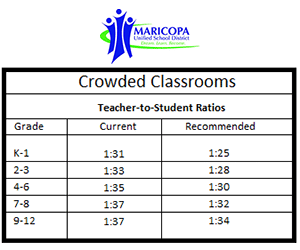Classes are crowded in the Maricopa Unified School District.
It is not a circumstance unique to MUSD. Arizona is ranked third in the country, behind only California and Utah, in its student-to-teacher ratio of 21.3, according to the National Center for Education Statistics. Across the country in 2014, those ratios began to decline as districts found ways to hire more teachers in a recovering economy.
But at MUSD, the situation remains at a critical level. That is the analysis of the district’s internal committees.
The current district target of students-per-teacher in kindergarten and first grade is 31. At the high school, that ratio is 37-to-1.
The MUSD Budget Committee has ranked class size as a critical priority. The Meet and Confer Committee describes lowered student-teacher ratios as providing better learning environments and “a positive recruitment and retention incentive for both employees and parents.”
“The bottom line is, we have to reduce class size,” MUSD board member Torri Anderson said.
Committee recommendations are to lower the target class sizes across the board. That includes 25 students per teacher in kindergarten and first grade, 28 in second and third grade, 30 in fourth through sixth grade, 32 in seventh and eighth grade, and 34 in high school.
Human Resources Director Tom Beckett said the class-size issue was addressed last year. This year, the Certified Salary Committee separated seventh and eighth grades from the high school in order to look at those numbers more closely. Like the high school, the current target ratio in those grades is 1:37.
In general, it is a wish list. The new recommendations, he said, “are something we would love to see happen.”
That would mean adding an estimated 15 full-time employees.
Superintendent Steve Chestnut said that would require $810,000. And that, he said, “is very much not in the cards.”
***ADVERTISEMENT***Though money could be coming into districts through the lawsuit filed against the state over inflation-adjusted funds, state cuts in other areas could negate that, he said.
Beckett said everyone understands that to have smaller classes, more teachers are necessary, and that could mean less money to adjust salaries. He said the Certified Salary Committee is making the “class size versus pay raise” discussion a particular focal point.
“There is a great desire to hire additional teachers, but it’s going to be very difficult to do,” Chestnut said. “If we could afford to hire a handful, that would be wonderful.”




![Maricopa sheds tears amid Maui wildfires that killed dozens For Maricopa resident Janelle Gomez, the sorrow mirrors the loss of a family member. [Brian Petersheim]](https://www.inmaricopa.com/wp-content/uploads/2023/08/Gomez-218x150.jpg)
![Embracing Freedom: Celebrating the Fourth of July Councilmember Vincent Manfredi at Great American 4th 2021 [Victor Moreno]](https://www.inmaricopa.com/wp-content/uploads/2023/07/2021-Great-American-4th-e1688414543522-218x150.jpg)









![Shred-A-Thon to take place tomorrow An image of shredded paper. [Pixabay]](https://www.inmaricopa.com/wp-content/uploads/2024/03/shredded-paper-168650_1280-100x70.jpg)


